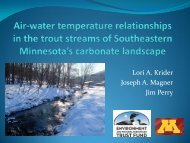Minnesota Water Resources Conference - Water Resources Center ...
Minnesota Water Resources Conference - Water Resources Center ...
Minnesota Water Resources Conference - Water Resources Center ...
Create successful ePaper yourself
Turn your PDF publications into a flip-book with our unique Google optimized e-Paper software.
Concurrent Sessions III 3:15–4:45<br />
Track B: Pesticides, Contaminants of Concern, and Emerging Contaminants<br />
Fermentation Processes: Effect on Contaminant Partitioning and <strong>Water</strong> Quality<br />
Denice Nelson, University of <strong>Minnesota</strong>, nels1083@umn.edu; Paige Novak, University of <strong>Minnesota</strong><br />
BOOK OF ABSTRACTS<br />
Tuesday, Monday, October 27 23<br />
The addition of carbon to a groundwater aquifer can be intentional, as in the case of bioremediation<br />
applications, or unintentional, as in a spill of readily degradable compounds that can serve as substrate<br />
for microbial growth. The addition of carbon, regardless of intent, promotes the growth of a fermentative<br />
community capable of producing cosolvents (some of which are regulated in groundwater) or biosurfactants<br />
that affect the physical and chemical structure of water, thereby influencing the behavior of hydrophobic<br />
contaminants. In addition, potentially large volumes of methane gas can be produced as a result of these<br />
fermentative processes. Our research quantifies the type, quantity and effect of fermentation products<br />
stemming from carbon inputs through partitioning and column experiments. Data can be used to optimize<br />
bioremediation systems to enhance removal of contaminants, mitigate formation of regulated compounds, and<br />
manage spills of other degradable carbon sources.<br />
Identification and Degradation of Industrial Phytoestrogens<br />
Mark Lundgren, University of <strong>Minnesota</strong>, lund0583@umn.edu; Paige Novak, University of <strong>Minnesota</strong><br />
Plants produce a range of phytochemicals that, due to their chemical similarity to naturally produced<br />
hormones, have the ability to cause estrogenic and antiestrogenic effects. These phytoestrogens are known<br />
to be present in many plants that are processed industrially. The goal of this research is to identify plantprocessing<br />
industries whose effluent contains detectable levels of phytoestrogens and to understand the fate of<br />
these compounds under typical wastewater treatment regimes. Other researchers have measured genistein, a<br />
common phytoestrogen, at levels up to 10.5 µg/L in wastewaters from the pulp and paper industry. Our work<br />
has shown that ethanol processes contain similar levels of genistein. Once more industries have been identified<br />
that have the potential to produce estrogenic waste streams, discharges can be monitored and treatment plants<br />
can be upgraded if necessary. This research is especially innovative because the investigation of industrial<br />
effluents for estrogenic compounds is nearly absent from the literature.<br />
A 2007 Assessment of Pesticides in <strong>Minnesota</strong> Lakes<br />
William VanRyswyk, <strong>Minnesota</strong> Department of Agriculture, bill.vanryswyk@state.mn.us; Steven Heiskary, <strong>Minnesota</strong> Pollution<br />
Control Agency<br />
In 2007 the <strong>Minnesota</strong> Department of Agriculture (MDA) cooperated with the <strong>Minnesota</strong> Pollution Control<br />
Agency (MPCA) in a statewide assessment of pesticides in <strong>Minnesota</strong> lakes as part of the National Lakes<br />
Assessment coordinated by US EPA. Fifty two lakes were randomly selected and sampled by MPCA and EPA<br />
staff around the state. Samples were analyzed by the MDA laboratory for 38 common pesticides and their<br />
degradates. Pesticides and/or degradates were detected in 91 percent of the samples collected. Atrazine was<br />
the most frequently detected compound. All detections were well below established water quality standards or<br />
reference values. Pesticide detections were widespread including lakes from many non-agricultural areas of the<br />
state.<br />
<strong>Minnesota</strong> <strong>Water</strong> <strong>Resources</strong> <strong>Conference</strong>, October 27–28, 20078 32
















